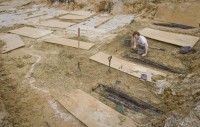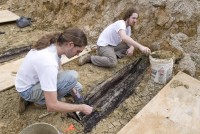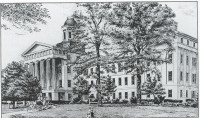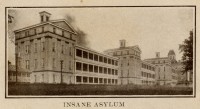 In 2013, workers building a new road on the campus of the University of Mississippi Medical Center (UMMC) in Jackson unearthed the remains of 66 individuals buried in pine coffins. These were remains of patients of the Mississippi State Lunatic Asylum, in operation between 1855 and 1935, who had been buried in an area of the campus that is now known as Asylum Hill, for obvious reasons. The remains were removed to the Mississippi State University anthropology department for study before reburial in the University of Mississippi Medical Center’s cemetery where donated anatomical and past archaeological human remains are interred. Road construction continued.
In 2013, workers building a new road on the campus of the University of Mississippi Medical Center (UMMC) in Jackson unearthed the remains of 66 individuals buried in pine coffins. These were remains of patients of the Mississippi State Lunatic Asylum, in operation between 1855 and 1935, who had been buried in an area of the campus that is now known as Asylum Hill, for obvious reasons. The remains were removed to the Mississippi State University anthropology department for study before reburial in the University of Mississippi Medical Center’s cemetery where donated anatomical and past archaeological human remains are interred. Road construction continued.
Remains have been found before on Asylum Hill, but after the discovery of the 66 coffins, tests were done on 20 acres of the UMMC campus where extensive construction was planned, and experts found evidence of 1,000 bodies buried there, maybe more. Now a ground-penetrating radar study has found there are at least 2,000 bodies buried on those 20 acres, and there may be as many as 7,000. The staggering numbers pose a thorny problem, because it costs $3,000 to exhume and rebury a single body. At a $21 million price tag, it would be prohibitively expensive to rebury all of the dead, even if they had room in the UMMC cemetery to accommodate so many bodies.
 It’s also far from an ideal solution for the many descendants who are desperate for information about their relatives and for a proper burial where they can pay their respects. Read the comments on my previous article for just a tiny sample of people who have searched high and low for any clue about the fate and whereabouts of their family members. Perhaps there’s a solution that can address both the financial hardships and give solace to the survivors of the Mississippi State Lunatic Asylum’s patients.
It’s also far from an ideal solution for the many descendants who are desperate for information about their relatives and for a proper burial where they can pay their respects. Read the comments on my previous article for just a tiny sample of people who have searched high and low for any clue about the fate and whereabouts of their family members. Perhaps there’s a solution that can address both the financial hardships and give solace to the survivors of the Mississippi State Lunatic Asylum’s patients.
Now UMMC is studying the cheaper alternative of handling those exhumations in-house, at a cost of $400,000 a year for at least eight years. It also would create a memorial that would preserve the remains with a visitors center and a lab that could be used to study the remains as well as the remnants of clothing and coffins.
Ralph Didlake, who oversees UMMC’s Center for Bioethics and Medical Humanities, believes the lab would be the first of its kind in the nation — giving researchers insight into life in the asylum in the 1800s and early 1900s.
“It would be a unique resource for Mississippi,” said Molly Zuckerman, associate professor in Mississippi State’s department of anthropology and Middle Eastern cultures. “It would make Mississippi a national center on historical records relating to health in the pre-modern period, particularly those being institutionalized.”
 There were no dedicated state facilities for the mentally ill in Mississippi before the Mississippi State Lunatic Asylum was built. The insane were kept at home, when families could handle it, and chained up in prisons with criminals when they couldn’t. Conditions were opprobrious. The Mississippi State Lunatic Asylum was designed according to the Kirkbride Plan, a new approach to the treatment of mental illness devised by Quaker physician Dr. Thomas Story Kirkbride premised on the then-novel theory that insanity could be curable and that the environment in which patients were treated played a key role in their recovery. The facilities had to be cheerful, airy, with social spaces like dining rooms and parlors reminiscent of home. Patients were to get plenty of time enjoying the grounds, both for pleasure and to farm the land as an early form of occupational therapy.
There were no dedicated state facilities for the mentally ill in Mississippi before the Mississippi State Lunatic Asylum was built. The insane were kept at home, when families could handle it, and chained up in prisons with criminals when they couldn’t. Conditions were opprobrious. The Mississippi State Lunatic Asylum was designed according to the Kirkbride Plan, a new approach to the treatment of mental illness devised by Quaker physician Dr. Thomas Story Kirkbride premised on the then-novel theory that insanity could be curable and that the environment in which patients were treated played a key role in their recovery. The facilities had to be cheerful, airy, with social spaces like dining rooms and parlors reminiscent of home. Patients were to get plenty of time enjoying the grounds, both for pleasure and to farm the land as an early form of occupational therapy.
The problem with the Kirkbride Plan when implemented by state asylums is that it required no more than 250 patients be admitted at one time. That was the magic number to ensure the space was conducive to healing and that there was sufficient staff to provide individual attention. But the states who invested serious money building these asylums — it took almost five years for the Mississippi legislature to appropriate funding for construction of theirs — had big problems adhering to Kirkbride’s ideal population density.
 The Mississippi State Lunatic Asylum started off with the best of intentions. There were 150 inmates when it opened in 1855. After the Civil War, the numbers started to rise. In 1870 there were 300 patients. By the end of Reconstruction in 1877, the Mississippi legislature stopped funding maintenance and oversight, and as a result the asylum rapidly declined. Within a year the new superintendent described the conditions as “verging on what the original Bedlam must have been like.” The inmate population continued to rise through fires, polluted water, desultory repairs and additions. In 1920 there were 1,670 patients. In 1930, there were 2,649. At its peak, there were 6,000 patients. Finally the run-down, massively overcrowded conditions could no longer be ignored. When a new state hospital opened in Whitfield in 1935, the old one was closed and all remaining patients were moved to the new facility.
The Mississippi State Lunatic Asylum started off with the best of intentions. There were 150 inmates when it opened in 1855. After the Civil War, the numbers started to rise. In 1870 there were 300 patients. By the end of Reconstruction in 1877, the Mississippi legislature stopped funding maintenance and oversight, and as a result the asylum rapidly declined. Within a year the new superintendent described the conditions as “verging on what the original Bedlam must have been like.” The inmate population continued to rise through fires, polluted water, desultory repairs and additions. In 1920 there were 1,670 patients. In 1930, there were 2,649. At its peak, there were 6,000 patients. Finally the run-down, massively overcrowded conditions could no longer be ignored. When a new state hospital opened in Whitfield in 1935, the old one was closed and all remaining patients were moved to the new facility.
The structure was demolished, and in 1954 the University Medical Center was built on the site. Construction workers have encountered bodies and headstones ever since, but nobody did a thorough investigation or really conceived of the massive scale of burials until the 2013 discovery.
Didlake, Zuckerman and others have formed the Asylum Hill Research Consortium, made up of anthropologists, archaeologists, historians and even an expert in dating the wood of the coffins.
It was the consortium that developed the memorial/visitors center/lab plans.
“We have inherited these patients,” Didlake said. “We want to show them care and respectful management.”
That’s an important step in the right direction, but I like Karen Clark’s idea cited in the news article to collect DNA from descendants so there’s a chance the bodies could be identified. Her three-times great-grandfather, Isham Earnest, was an inmate at the Mississippi State Lunatic Asylum in its early days and is believed to have died there in the late 1850s. Depending on conditions of the remains, nuclear DNA may not be retrievable, although mitochondrial DNA is much hardier. The oldest of the remains are just over 150 years old, which is quite fresh, really, from an archaeological perspective, so it’s certainly within the realm of possibility. It’s an ambitious project and would require significant additional funding. It would so worthwhile, though.